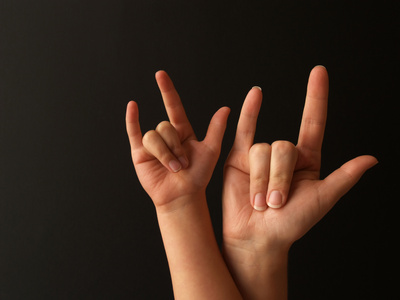DOES BABY SIGN LANGUAGE REALLY WORK?

Sure…give it a try.
Long before our daughter arrived…or was even on the way…we had heard about friends teaching their babies sign language in order to help them better communicate prior to learning to talk. My wife and I were both intrigued and agreed that this was something that we would try. The sooner we could communicate with our baby the better.
It is widely accepted/known that babies usually have the ability to communicate long before they are able to speak. This often leads to frustration for both the baby and the parents, as this communication breakdown is often at the core of basic fussiness and tantrums. Sign language can often allow parents to quickly understand what is bothering their baby or what the baby needs, and to resolve the situation quickly…which is obviously great for all involved.
We were not quite sure where to begin, so we started in the most logical places…a bookstore, the library, and the Internet. One of the books we picked up was Baby Signing For Dummies. We skimmed through it and learned some good high level information such as when and how to introduce signing to your baby. From there, we mainly relied on some cheat sheets that we pulled from the Internet.
To find these cheat sheets, go to Google, search for “baby sign language chart”, hit the images tab for a bunch of decent options, and print out a few to keep around for reminders. This chart was probably the most useful for us… http://www.babies-and-sign-language.com/images/chartbwbig2.jpg. It is very basic, but has most of the key signs. The ones we use the most are eat/food, milk, more, finished/all done, thank you, and please. We were using mother and father, but then our daughter just started saying those instead (mama/dada). :)
We started introducing signing to our daughter pretty early on, around 4-5 months, primarily before/during/after feeding her a bottle. She seemed to start understanding some of the signs around 9-10 months, and she started using some of them herself around 12 months (eat/food, milk, and more)…which was definitely pretty cool. Over the past couple months, we have continued to practice signing with her, and have introduced a few more to her (I love you, please, thank you, and dirty diaper). However, at nearly 15 months, she is now trying to just speak the words instead, so it seems that our days of signing may be limited.
Definitely give it a shot, but please remember to be patient, persistent, and consistent. The first time your baby signs back, it will make it all worth while. Enjoy! …and please share your own stories of success and challenges with teaching sign language to your baby.
“Sign & Sing” teaches children and parents early communication skills.
Class length: 40-50 minutes
From the moment you meet him or her, you want to understand your baby. What is he thinking? Is she hungry, tired, too cold, content? Early on your baby also has an innate desire to communicate with you.
In a Kindermusik Sign & Sing class (developed by Signing Smart™), we give you and your child the tools and knowledge to communicate with each other using American Sign Language. Through songs and play, you’ll both learn signs for words like “mommy”and “eat,” and you’ll know if he wants “more” “milk” and when he’s “all done.” This research-proven signing class for hearing children speeds language development, eases frustration, and enhances long-term learning abilities.
WHAT YOU’LL EXPERIENCE IN CLASS
• You’ll play, sign, and sing. Using everyday items in engaging small and large group activities, we’ll sing songs and practice the sign as we say the words, play with toys, and help her learn both the spoken word and the sign.• Expert advice. You’ll learn to spot your baby’s most “teachable moments” and the sign language teaching methods ofthe experts. Plus you’ll learn to recognize and respond to your child’s versions of signs.
• Communication through sign language. When your child is chasing a bubble or asking for the ball, you’ll make the sign for it and say the word. So she has the ways to associate the word with the object: she holds the ball, she hears you say the word, and she sees you make the sign.
ENROLLMENT INCLUDES
• Developmentally appropriate American Sign Language curriculum for parents and hearing children, ages 6 months to 3 years• 5 to 10 week semester (can vary by location)
• Weekly 40-50 minute class (can vary by location)
• At Home Materials that includes a Family Activity Guide, DVD, and Clip-On Flashcards showing adults and children using signs
• Over 75 sign language activities and games to play together.
Classes begin March 5th and March 15th.
At The Muse in downtown Willits.
No comments:
Post a Comment